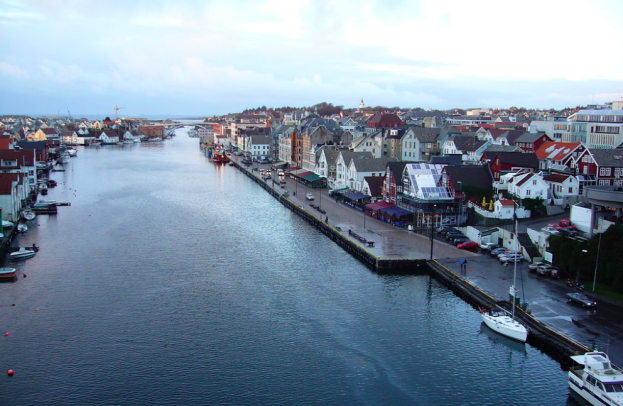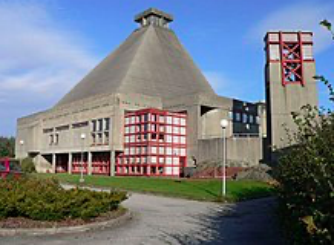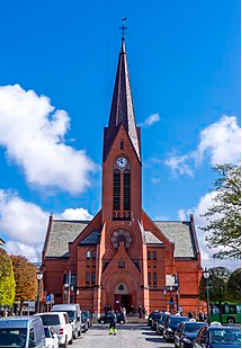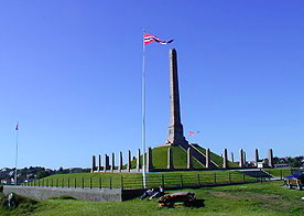Haugesund,Norway 作者: 来源: 发布时间:2021-02-19
一、所属省或是州,具体位置,人口,面积
Haugesund is a municipality on the North Sea in Rogaland county, Norway. The town of Haugesund is the main population center and administrative center of the municipality. The town is also the main commercial and economic center of the Haugaland region in northern Rogaland and southern Vestland. The majority of the population of Haugesund lives in the town of Haugesund, with the majority of the municipality outside the town being fairly rural.

The 72.68-square-kilometer (28.06 sq mi) municipality is the 338th largest by area out of the 356 municipalities in Norway. Haugesund is the 28th most populous municipality in Norway with a population of 37,357. The municipality's population density is 546.4 inhabitants per square kilometer (1,415 / sq mi) and its population has increased by 9.7% over the previous 10-year period. The town of Haugesund (which actually crosses over slightly into the neighboring municipality of Karmøy) makes up about 15.5 square kilometers (6.0 sq mi) within the municipality. The town has a total of about 36,468 residents and the urban area of the town actually crosses over into the neighboring municipality of Karmøy (an additional 8,884 people live in the town's urban area that spreads over into Karmøy municipality). This means that only about 1,000 residents of Haugesund municipality that live outside the town of Haugesund in the 57-square-kilometer (22 sq mi) rural portion of the municipality.
二、自然地理
1.地理条件
The town is situated on a strategically important sound, the Karmsundet, through which ships could pass without traversing heavy seas. In the early years, the coastal waters off Haugesund were a huge source of herring, and the town grew accordingly. Despite being barely a village back then, King Harald Fairhair lived at Avaldsnes, very close to the modern town of Haugesund. In the last decades, the town, like its neighbors, has been turning towards the petroleum industry, with the herring being long gone. During the last 20 years, the municipality has established its position as the main trading center for the Haugaland region and southern parts of Vestland county. It has several relatively large shopping centers, however, this has led to a decline of the trade and shopping activity in the town center.
Haugesund municipality has a coastline with the North Sea, however, the island of Karmøy and the archipelago of Røvær shelter it from the rough waters of the ocean. The Karmsundet strait, located between Karmøy and Haugesund used to be very strategically important, since ships could pass without having to sail through heavy sea. Haugesund's city center has a distinctive street layout, similar to those found in Kristiansand and Oslo. Haugesund has a typical maritime climate with mild winters, cool but pleasant springs, and mild summers lasting until the end of September. Monthly 24-hr average range from 1.1 ° C (34.0 ° F) in February to 14 ° C (57 ° F) in August. Mean annual precipitation is 1,520 millimeters (60 in), with September to December as the wettest period.
The municipality includes several islands. Risøy and Hasseløy are densely built, and connected to the mainland by bridges. Røvær which lies further out and consists of a number of islands, is also populated and connected to the mainland by ferry. Vibrandsøy and its neighboring islands are now mainly a recreational area. Røværsholmen Lighthouse sits just off the coast of the main Røvær island. The lakes Vigdarvatnet and Stakkastadvatnet are located in the municipality.
2. 交通情况
Haugesund Airport, located on the island of Karmøy to the southwest of Haugesund in Karmøy municipality, has year-round flights to Oslo and Gdańsk in addition to some seasonal and charter destinations. The Norwegian airline Coast Air was based at Haugesund airport, but filed for bankruptcy on 23 January 2008. The European Route E39 bypasses Haugesund to the east, passing through Aksdal. The European Route E134 leads eastwords to Drammen outside Oslo.
The bus station in Haugesund is located at Flotmyr on the east side of the downtown area. Long-distance bus services are available to Stavanger, Bergen, and Oslo. The local bus transport is operated by Vy Buss, on a contract with Kolumbus. The town is connected to the island of Utsira by car ferry, and to the islands of Røvær and Feøy by passenger ferry. Until 2008, the Newcastle – Bergen – Stavanger ferry operated here as well.
三、经济发展和规模
Many jobs in Haugesund are connected to the maritime sector within shipbuilding, shipping and education. Examples of important players in the industry are Stord / Haugesund University College, Aibel, the Norwegian Maritime Directorate and the Norwegian Coastal Administration. The Norwegian Coastal Administration in Haugesund also hosts the North Atlantic Information Management Center, which is 1 of 5 information centers in the EU. The center monitors and coordinates all ship traffic in Norway, Iceland, Denmark, Greenland, the Faroe Islands and the United Kingdom. In 2011, the Haugesund Conference, one of Norway's most important maritime conferences, will be held for the 18th time.
Retail is also an important industry in Haugesund, and the large selection of shops and department stores attracts customers from large parts of Haugalandet. In 2009, the city was Rogaland's largest and Norway's fourth largest trading town with an average turnover of NOK 126,443 per. innbybgger. In comparison, the average turnover in Norwegian municipalities was NOK 51,992 per inhabitant.
The growth in the number of jobs is going in waves. It is the development in the business sector that has created the waves since 2000. There was a decline in the number of jobs in 2002-2003, in 2009 and in 2015-2016. The decline was linked to three crises during this period: the dotcom crisis, the financial crisis and the oil crisis.
The development in the number of jobs in the public sector has been steady and strong throughout the period after 2000. Growth in the public sector has probably been underestimated, since several large public institutions have been privatized during this period.
Job growth has been unevenly distributed between different regions in the country. Nine of the ten regions in the country with the strongest job growth since 2000 are either around Oslo, Stavanger, Bergen, Trondheim or Kristiansand. The exception is Hitra / Frøya, which has had the strongest workplace growth with a growth of 40 per cent. Some regions have had a decline in the number of jobs since 2000. They are all district regions.
A prominent feature is the weak development that the most oil-dependent counties (Rogaland, Hordaland, Vest-Agder and Møre og Romsdal) had in 2015 and 2016 after the fall in oil prices at the end of 2014. The oil counties, especially Rogaland, again experienced stronger growth than the national average in 2018 and 2019. Oslo and Akershus have had stronger growth than the national average in all recent years. At the same time, the typical district counties have experienced increasingly weaker development relative to the rest of the country.
https://haugalandvekst.no/tema/om-regionen/
https://regionalanalyse.no/rapport/12007/1/1
四、产业特点重点项目
Statistics Norway publishes data from the first quarter of 2016, so that we can see the annual growth from the first quarter of 2017 until the third quarter of 2020. We can see that there was a stable growth in the number of employees of between one and two percent annually in the future. to Q1 2020.
In the second quarter of 2020, we had an abrupt fall, as a result of a shutdown in connection with the corona eruption in March. Then the annual growth in the number of employees fell from +1.2 percent in the 1st quarter of 2020 to -2.6 percent in the 2nd quarter of 2020. In the 3rd quarter of 2020 there was a decrease of 2.7 percent in the number of employees from the same quarter the year before.
It is first and foremost the business community that was affected by the corona crisis. The annual growth in the number of employees in the business sector in Norway went from +1.2 per cent in the first quarter of 2020 to -3.9 per cent in the second quarter of 2020. In the third quarter, the decline continued. The annual growth in the number of employees in the business sector in Norway is now -4.2 per cent.
Haugalandet saw a fall in the annual growth in the number of employees in the second quarter, which was about as sharp as the fall in the country. There was a decrease of 2.8 per cent in the number of employees from the second quarter of 2019 to the second quarter of 2020. There were small changes in the annual growth in the number of employees in the third quarter of 2020.
Some regions, such as Ytre Helgeland, Dalane, HALD, Sunnhordland and Ringerike, have seen growth in the number of employees in the last 12 months. Regions with a particularly sharp decline are Central Finnmark, Setesdal, West Telemark, Nord-Gudbrandsdal and Valdres. Upper Romerike with Gardermoen is also among the regions with the largest decline. These are regions with a lot of tourism, one of the industries that was hardest hit by the measures against corona.
If we look at the development with the old county boundaries, we can see that Finnmark and Oppland have had the most negative development. Rogaland has had the best development and has had almost no decline in the number of employees in the last year.
In the third quarter of 2020, Upper Romerike has the strongest decline in the number of employees in the regions. Regions such as Midt-Finnmark, Midt-Gudbrandsdal and Sogn have also experienced a sharp decline. Transport and tourism have been most strongly affected and regions with a large share in these industries have therefore so far been most affected. Some regions have had growth in the business sector from the third quarter of 2019 to the third quarter of 2020, such as Ytre Helgeland, HALD, Sør-Helgeland and Dalane.
https://haugalandvekst.no/tema/om-regionen/
五、风景名胜,景点( attractions)
1. Rossabø Church

Rossabø Church (Norwegian: Rossabø kyrkje) is a parish church of the Church of Norway in Haugesund Municipality in Rogaland county, Norway. It is located in the southern part of the town of Haugesund. It is the church for the Rossabø parish which is part of the Haugaland prosti (deanery) in the Diocese of Stavanger. The modern-style, concrete church was built in a fan-shaped style in 1972 using designs by the architects Per Amund Riseng and Jan Stensrud. The church seats about 360 people, but can be expanded up to 600 people.
2. Our Savior's Church

Our Savior's Church (Norwegian: Vår Frelsers kirke) is a parish church of the Church of Norway in Haugesund Municipality in Rogaland county, Norway. It is located in the center of the town of Haugesund. It is the church for the Vår Frelser parish which is part of the Haugaland prosti (deanery) in the Diocese of Stavanger. The large, red brick church was built in a cruciform design with a Neo-gothic style in 1901 using designs by the architect Einar Halleland. The church seats about 850 people.
3. Haraldshaugen

The national monument Haraldshaugen, locally also known as Haraldsstøtten, is a monument commemorating Harald Hårfagre's unification of Norway in 872. The support was unveiled in 1872 in connection with the millennium anniversary of the battle of Hafrsfjord, where Norway was united into one kingdom. The monument stands on Gard just north of the town center in Haugesund at the place where Harald Hårfagre is said to have been buried.
The monument was designed by architect Christian Christie, as a large burial mound surrounded by a granite wall with 29 monumental stones, one from each of the old Norwegian counties. At the top of the mound is a 17 meter high granite obelisk, with four bronze panels around the base. Each of the panels depicts important scenes from Harald Hårfagre's life and life.
Haraldshaugen has been one of Haugesund's foremost treasures ever since the unveiling. In connection with the turn of the millennium, Haraldshaugen was chosen as Haugesund's millennium site.
六、历史文化
1.历史
Despite being a fairly young town, the areas surrounding Haugesund were lands of power during the Viking Age. Harald Fairhair was the first king of Norway. He had his home in Avaldsnes, also known as Homeland of the Viking Kings, only 8 km (4.9 mi) from the present town. [8] [9] After his death in c. 940, Fairhair was buried at Haraldshaugen, a burial mound adjacent to the Karmsundet strait. [10] This site is the namesake of the town and municipality of Haugesund. The national monument at Haraldshaugen was raised in 1872, to commemorate the 1000th anniversary of the Battle of Hafrsfjord in 872. The Battle of Hafrsfjord has traditionally been regarded as when western Norway was unified under a single monarch for the first time.
Haugesund has a strong historical bond to the sea and especially the herring. In the earlier years, the coastal waters of Haugesund were a huge source for fishing herring, and the town grew accordingly. The protective straits of Smedasund and Karmsund gave the town potential to grow in both fishing and shipping. Even to this day, Karmsund is one of Norway's busiest waterways. The town is still growing geographically even though the population has increased only moderately the last decade. Today the herring is long gone, and the town is turning more and more towards the petroleum industry, like its neighboring town to the south, Stavanger.
The urban village area of Haugesund (population: 1,066) was declared to be a "town" and it was separated from the surrounding municipality of Torvastad on 1 February 1855 to become a separate municipality of its own. On 1 January 1911, a small urban area of Skåre (population: 3,847) that directly abutted the town of Haugesund was transferred to Haugesund. On 1 January 1958, the remainder of the municipality of Skåre was merged with the town of Haugesund, creating a larger Haugesund municipality. On 1 January 1965, the island of Vibrandsøy (population: 70) was transferred from Torvastad municipality to Haugesund.
2. 文化体育
Haugesund is the main cultural center for its region, and is home to several festivals, the largest being the Norwegian International Film Festival and Sildajazz, an international jazz festival with approximately 70 bands and close to 200 concerts. Every August, The Norwegian Trad-jazz festival, the Sildajazz is held. Both local and international musicians are presented at the Sildajazz.
In the summer of 2004, the annual rock festival, "" RockFest "" started. It attracted local, national and international pop and rock bands, such as Elton John, Madcon, DumDum Boys and Kaizers Orchestra. The festival started as a part of the celebration of Haugesund's 150 year anniversary. In 2009, the last Rockfest was held, and got replaced by a new concept in 2010; Haugesund Live. Haugesund Live is a series of individual concerts, and has featured bands such as The Baseballs, Kim Larsen and Mötley Crüe.
The soccer team from Haugesund, FK Haugesund is playing in the Norway's highest league, Tippeligaen. The Norwegian International Film Festival has since 1973 been held in Haugesund, premiering and showing international and Norwegian films. The Amanda Award, Norway's variation of the Oscars, has been held in Haugesund since 1985 in competition with the film festival.
Haugesunds Avis is a daily newspaper published in Haugesund, but with branches in Bømlo, Kopervik, Odda, Sauda and Stord. Founded in 1895, it is today owned by the investment group Mecom Group, and is as such part of the media group Edda Media. In 2006, Haugesunds Avis had a circulation of 33,448. As of 2007, the executive editor is Tonny Nundal. The newspaper owns the local radio channel Radio 102.
Fotballklubben Haugesund (English: Football Club Haugesund), usually referred to as FK Haugesund or FKH, is a professional Norwegian football club from the city of Haugesund, Rogaland, Norway. The club currently plays in the Norwegian Eliteserien, the first tier in the Norwegian football league system, after having been promoted in the 2008-season.
FK Haugesund previously played in the top division in 1996-1998 and 2000. The club have been runners-up in the Norwegian Cup in 2007 and 2019 as well as having competed in the qualifying stages for the UEFA Europa League in 2014–15, 2017 –18 and 2019–20. The club's best achievement in the national league is the bronze medal in Eliteserien in 2013, and fourth place in the 2016 and 2018 seasons.
It was originally founded on October 28, 1993, after a merger between the Haugesund-based football clubs Djerv 1919 and SK Haugar. Their current head coach is former player, head coach and sporting director Jostein Grindhaug. The club plays its home matches at the Haugesund stadion near the city-center of Haugesund. The stadium has a capacity of 8 754. Maakeberget is the official but independent supporter club of FK Haugesund.
七、其他信息
The coat of arms for Haugesund was granted on 5 March 1930. They were designed by Hallvard Trætteberg. The arms are blue with three silver / white seagulls lined up vertically. The seagulls and blue color were chosen to represent the importance of the sea. These arms replaced the old coat of arms that were granted on December 29, 1862. The old arms showed three herring barrels, an anchor, and three seagulls. The old arms showed the importance of herring fishing and processing in the town. The three barrels also represented the three parts of the municipality: the mainland and the islands of Hasseløy and Risøy. The new arms from 1930 removed the herring barrels due to the decline in the importance of that industry.
八、联系方式
Town manager: Petter Steen jr
Phone:52 74 30 00
Address:Kirkegata 85, 5528 Haugesund
